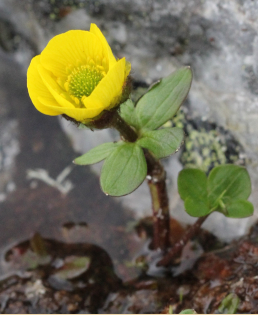The Snow Buttercup
Psalm 103:15-17
“
Wikipedia has very little to say about the Snow buttercup – Ranunculus nivalis. This is what it says:
Heliotropism is a fascinating property. It means that the flower tracks the position of the sun during the day, moving its little yellow parabolic flowers by using special motor cells so that it is constantly pointing towards the sun, as if it were a little radio telescope. The plant grows to about 6 inches high, and its flower is between half and one inch across. As it is the shape of a parabolic dish, it reflects the heat from the sun to a focal point, which is just about where the anther and stamens are positioned. Now, this flower grows in very cold environments so this small amount of extra warmth is very welcome – especially to pollinating insects. Such insects are attracted to the warm spot and are, therefore, more likely to collect or distribute pollen than with a regular-temperature flower. It is undeniable that this gives the snow buttercup an advantage in the competition for pollinators. But I am using evolutionary language. Why is there a competition? How did this flower achieve such an advantage? This property could not have evolved, as the pre-evolved plants would have died in the cold. This is a feature which could only have been designed by God.
Prayer: In Your word, Lord, You tell us that we are worth much more than the flowers which You clothed. Thank You, Lord, for Your care for us. Amen.
Author: Paul F. Taylor
Image: CC BY-SA 3.0 Unported.
© 2021 Creation Moments. All rights reserved.